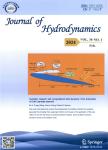NUMERICAL STUDY ON THE PURIFICATION PERFORMANCE OF RIVERBANK
NUMERICAL STUDY ON THE PURIFICATION PERFORMANCE OF RIVERBANK作者机构:College of Environmental Science and Engineering Hohai University Nanjing 210098 China
出 版 物:《Journal of Hydrodynamics》 (水动力学研究与进展B辑(英文版))
年 卷 期:2007年第19卷第5期
页 面:643-652页
核心收录:
主 题:riverbank numerical modelling purification,pollutant experiments
摘 要:During the rain time, the runoff infiltrates into the riverbank through the collecting gutter and slope surface. The city runoff is generally polluted by organic, oil, heavy metal particulates, etc. The pollutants moving with the water through the riverbank experience advection, dispersion, diffusion, adsorption, biochemical reaction and plant uptaking processes. In this article, a mathematical model was developed to simulate the performance of pollutant removal of the riverbank. The model took those main mechanisms into account. The modified Richards equation was used in simulating flow field. The mass balance law was employed in deriving the equation for pollutant transport, where the diffusion and dispersion were described with the Fick-type law, the adsorption was macroscopically expressed as form isotherm, and the bio-chemical degradation process was assumed to follow the Monod kinetics. The NH3-N and TP were considered in the present model. The mathematical model was descritized with a finite element numerical model, which was applied to two types of model riverbanks. In the model test, the hydraulic loading was assumed to have the intermittent pattern simulating the storm runoff of certain return period, and the values of the rainfall runoff and concentrations of the NH3-N and TP were taken from the model test. The computed overall removal rates for the NH3-N and TP in 6 cases are in the range of 88%-98%, 87%-97%, respectively. The differences between the computed and tested overall removal rates for the NH3-N and TP are less than 5%. The time-varying oscillation pattern of the concentrations of the NH3-N and TP were rationally simulated, which shows that the model presented in this article can be used to assess the purification performance of the riverbank constructed with sand or soil.



